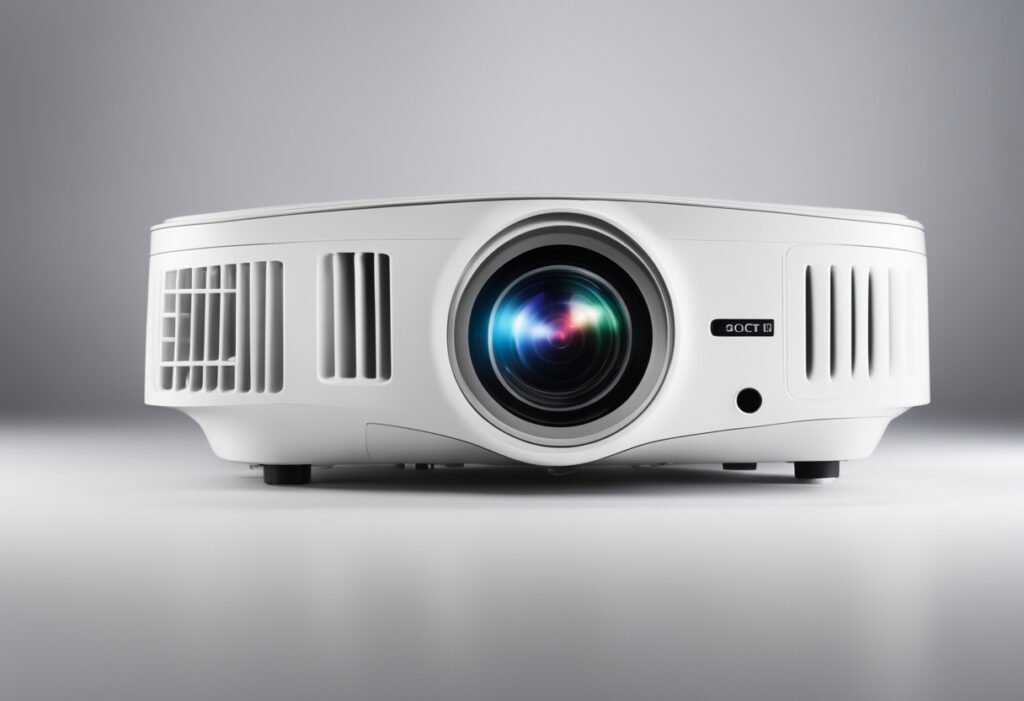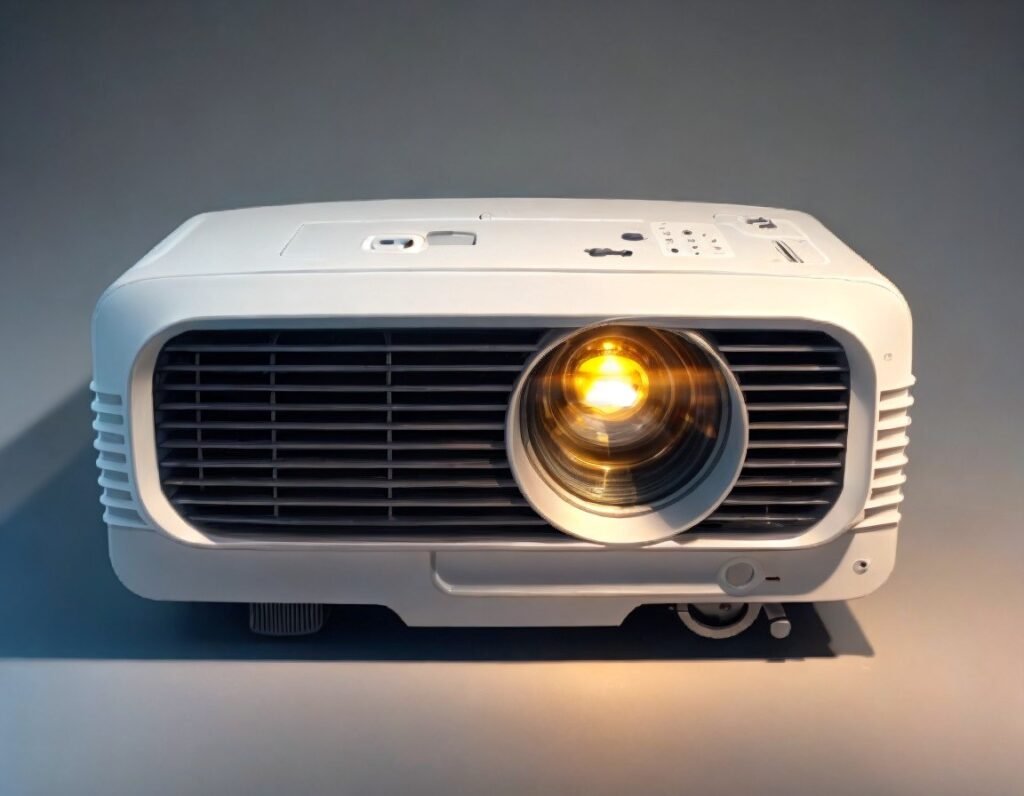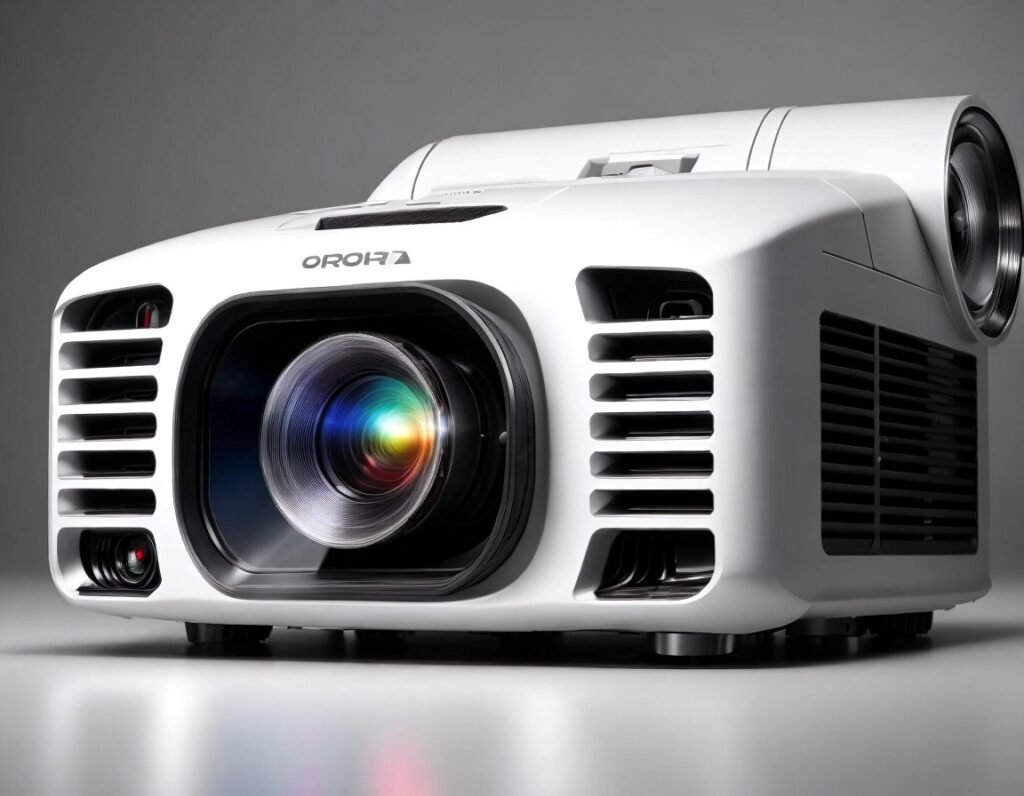
With better image quality and longer lifespan than conventional projectors, laser projectors have completely changed how we watch material in recent years. Selecting the ideal projector for your requirements can be made easier if you are aware of how laser projectors operate and the technology that supports them. To make sure you have all the information you need in one place, this in-depth guide will go into the specifics of laser projector technology, including its benefits, types, applications, and FAQs.
Table of Contents
What is Laser Projector Technology?
Lasers are the light source used by laser projector technology to show images and videos. Light is produced by laser diodes in laser projectors as opposed to conventional projectors, which rely on lamps or LEDs. As a result, the projector lasts longer and produces brighter, more accurate colours.
Brief History
The weaknesses of conventional lamp-based projectors gave rise to the development of laser projectors. The brightness, colour accuracy, and regular need for bulb replacements were problems with early projectors. These problems were solved with the development of laser technology, which offered a more reliable and efficient light source.
The importance
Due to its wide range of applications in home entertainment, business presentations, education, and large-scale public displays, laser projector technology is noteworthy. Many users find it to be their preferred option due to its capacity to produce photos that are crisp, bright, and brilliant.

How Do Laser Projectors Work?
Basic Principles
The basic idea behind how laser projectors work is that light is produced by laser diodes. Images are subsequently created by processing the light using an optical device. Here’s a thorough examination of the core ideas at play:
Light Origin
Laser diodes are the light source of laser projectors. High-intensity beams are produced by coherent light, which is produced by diodes and consists of uniform, in-phase light waves. Greater control over light output is made possible by the use of lasers, which results in improved brightness and colour accuracy.
Image Production
Depending on the type of projector, different processes are used to generate images in laser projectors. To generate an image, the essential processes are to modulate the laser light to create distinct colors, and then combine these colours.
- DLP (Digital Light Processing): To modulate the laser light, DLP projectors employ a digital micromirror device (DMD). The DMD’s tiny mirrors tilt to reflect light, which produces the image’s pixels. A colour wheel or individual lasers for red, green, and blue are used to add colour.
- 3LCD (Three-Liquid Crystal Display): 3LCD projectors employ three independent LCD screens to display green, blue, and red light, respectively. These panels let the laser light flow through and then alter it to create the image. After that, a lens is used to mix and project the three different coloured lights.
- LCoS (Liquid Crystal on Silicon): Liquid crystal panels on a reflecting silicon backing are used in LCoS (Liquid Crystal on Silicon) projectors. The image is produced by the liquid crystals modulating the laser light and reflecting it off the silicon. LCoS projectors use distinct panels for red, green, and blue light, just like 3LCD.
Important Elements
It is easier to understand how laser projectors work if one is aware of its primary components:
- Laser Diodes: The primary light source is composed of laser diodes, which produce luminous, well-focused light.
- Optical system: Prisms, mirrors, and lenses are used in the optical system to direct and alter laser light.
- Scanning Mirrors: Certain laser projectors employ scanning mirrors to focus the light beam so that the image is created across the screen.
- Projection lens: The purpose of the projection lens is to focus light onto the screen to display the final image.
Colour Rendering and Intensity
Laser projectors excel in brightness and colour accuracy. By carefully adjusting colour wavelengths with the use of laser diodes, vivid and lifelike colours are generated. Furthermore, laser projectors may be used in a range of lighting conditions due to their higher brightness compared to ordinary projectors.

What are the Advantages of Laser Projectors?
Longevity
Longer lifespans are among the main benefits of laser projectors. Traditional bulbs usually last between 2,000 and 5,000 hours, however, laser diodes can last up to 20,000 to 30,000 hours. This translates to fewer replacements needed more often and cheaper upkeep.
Brightness and Color
Better brightness and colour reproduction are provided by laser projectors. Greater brightness levels are possible without sacrificing image quality thanks to the coherent nature of laser light. More accurate and vivid colours are produced as a result of the precise control over laser wavelengths.
Energy Efficient
Compared to their lamp-based equivalents, laser projectors use less electricity. Their brightness levels are higher and they use less power. This lowers energy expenses while also making the setup more environmentally friendly and sustainable.
Instant On/Off
Laser projectors can be turned on and off quickly, in contrast to traditional projectors that need warm-up and cool-down times. This capability is especially helpful in situations like corporate presentations and schools when prompt setup and shutdown are crucial.
Maintenance
Laser projectors need very little upkeep. The sealed optical system keeps dust and debris from disrupting performance, and the long lifespan of laser diodes removes the need for regular light changes. As a result, the operation is more dependable and trouble-free.
Read More: Advantages of Laser Projectors over Traditional Projectors

Types of Laser Projectors
Digital Light Processing, or DLP
A digital micromirror device (DMD) is used by DLP laser projectors to alter light. A pixel in the image is represented by each mirror on the DMD. The image is created by the mirrors tilting to reflect light either onto or away from the screen. Sharp visuals and strong contrast ratios are characteristics of DLP projectors.
Three-Liquid Crystal Display, or 3LCD
Three distinct LCD panels are used by 3LCD laser projectors to modulate red, green, and blue light. These panels allow the laser light to travel through, producing the image. Excellent colour reproduction makes 3LCD projectors popular in settings where colour fidelity is crucial.
Liquid Crystal on Silicon, or LCoS
On a reflective silicon backing, liquid crystal displays are used in LCoS projectors. The image is produced by reflecting the laser light off the silicon after it has been modified by the liquid crystals. High-end home theatre installations frequently use LCoS projectors, which deliver high-resolution images.
Uses for Laser Projector Technology
Home Entertainment
The application of laser projectors in home theatre systems has increased in popularity. Their ability to produce colourful, sharp images makes them perfect for home entertainment setups. In comparison to conventional projectors, they also have a longer lifespan and require less maintenance, which makes them an affordable choice for extended usage.
Education and Business
Even in well-lit spaces, laser projectors produce crisp, brilliant images for use in commercial and educational environments. The low maintenance requirements and rapid on/off functionality make them ideal for classrooms and meeting spaces. Additionally, they are adaptable, having the ability to project at varied angles and on diverse surfaces.
Events and Public Displays
During public events like concerts, exhibits, and outdoor advertising, laser projectors are utilized. Even in enormous venues and with different lighting circumstances, images are visible thanks to their exceptional brightness and colour precision. Furthermore, laser projectors are suitable for continuous usage in challenging conditions due to their dependability and longevity.
Conclusion
With many advantages over regular projectors, laser projectors are a major jump in projection technology. They are ideal for a variety of uses, including public displays, business, and home entertainment due to their exceptional brightness, colour accuracy, and durability. When purchasing the right projector for your purposes, being aware of how laser projectors operate and the perks that they provide will help you make an informed choice. Long-term dependability and cost-effectiveness make laser projectors an excellent option due to their low maintenance needs and energy economy.
Frequently Asked Questions About Laser Projectors
How much time can a laser projector last?
The average lifespan of a laser projector can range from 20,000 and 30,000 hours. This outlasts conventional lamp-based projectors by a considerable margin, as they typically have a lifespan of 2,000–5,000 hours.
Do laser projectors cause a risk to eye health?
In general, laser projectors pose no risk to the eyes. They are made to reduce direct exposure to laser light and adhere to safety regulations. Still, it’s often a good idea to look away from the projector beam.
Can one use a laser projector during the day?
It is possible to utilize laser projectors during the day. Even in well-lit areas, they may create images that are visible and crisp because of their high brightness levels. In dim environments, the image quality might still be superior.
How do laser and LED projectors differ from one another?
While light-emitting diodes (LEDs) are used in LED projectors, laser diodes are the light source in laser projectors. If compared to LED projectors, laser projectors often provide far more brightness, improved colour accuracy, and a longer lifespan. However, LED projectors are frequently smaller and less expensive.
How should a laser projector be maintained?
Due to its minimal maintenance needs, laser projectors are often easy to maintain. Avoid obstructing the ventilation apertures and maintain the projector in a dust-free, clean atmosphere. To guarantee peak performance, periodically inspect for the manufacturer’s latest updates.
What aspects of purchasing a laser projector should I take into account?
Think about things like brightness, resolution, throw distance, contrast ratio, and connectivity choices when purchasing a laser projector. Additionally, consider the area in which the projector will be utilized and the unique use case (home theatre, corporate presentations, etc.).




